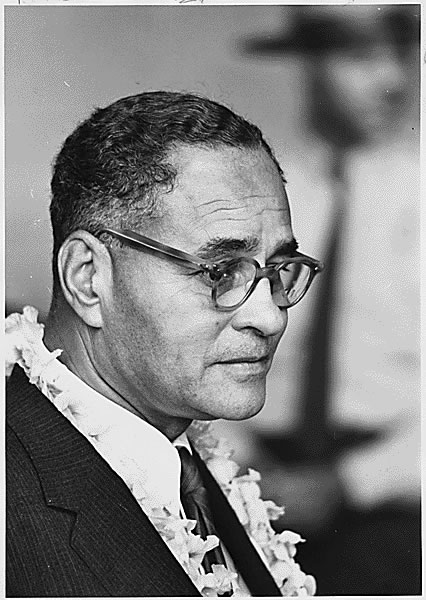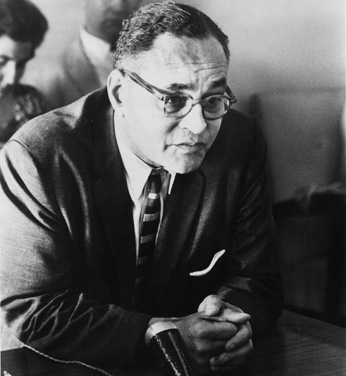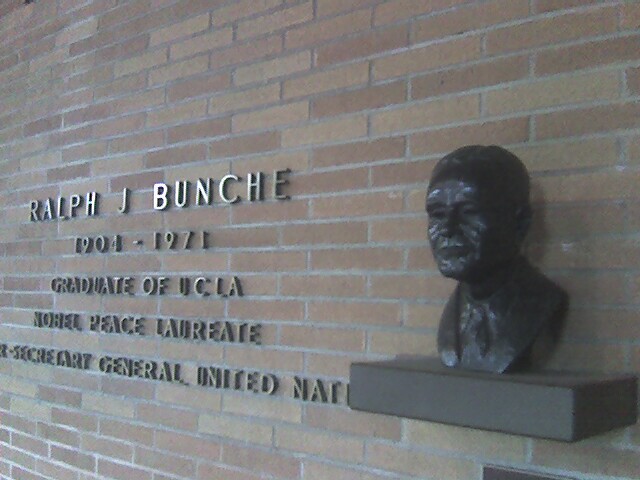<Back to Index>
- Humanist Conrad Lycosthenes, 1518
- Castrato Singer Luigi Marchesi, 1754
- Diplomat Ralph Johnson Bunche, 1903
PAGE SPONSOR



Ralph Johnson Bunche (August 8, 1903 disputed - 1904 – December 9, 1971) was an American political scientist and diplomat who received the 1950 Nobel Peace Prize for his late 1940s mediation in Palestine. He was the first person of color to be so honored in the history of the Prize. He was involved in the formation and administration of the United Nations and in 1963, received the Medal of Freedom from President John F. Kennedy.
Bunche was born in Detroit, Michigan, to an African American family and baptized at the city's Second Baptist Church. His father, Fred, was a barber, while his mother, Olive Agnes (née Johnson), was an amateur musician. His father had ancestors who were freed before the American Revolution. When he was a child, the family moved to Toledo, Ohio, then in 1915, Albuquerque, New Mexico, in an effort to improve his parents' health. His mother died in 1916, and his father, who had left Albuquerque to look for work before Olive's death, did not return for Ralph or his sister. His father remarried and Ralph never saw him again. Bunche and his sister, Grace, went to live in Los Angeles with their maternal grandmother, Lucy Taylor Johnson, though some sources list her name as Agnes Johnson.
Bunche was a brilliant student, a debater, and the valedictorian of his graduating class at Jefferson High School. He attended the University of California, Los Angeles, and graduated summa cum laude in 1927, again as the valedictorian of his class. Using the money his community raised for his studies, and a scholarship from the University, he studied at Harvard University. To help with his living expenses while at Harvard, Bunche sought a job at a local bookstore. The myopic owner, who did not realize Bunche was black, offered him a part time job. Bunche excelled at running the store to his employer's satisfaction until one day the owner called him into the office and said, "Folks tell me you're a Negro. I don't give a damn, but are you?" Bunche asked, "What did you think?" and the owner replied, "I couldn't see you clear enough."
At Harvard, he earned a master's degree in political science in 1928 and a doctorate in 1934, while he was already teaching in Howard University's
Department of Political Science. It was typical then for doctoral
candidates to start teaching before completion of their dissertations.
He was the first black American to gain a PhD in political science from
an American university. From 1936 to 1938, Ralph Bunche conducted
postdoctoral research in anthropology at London School of Economics (LSE), and later at the University of Cape Town in South Africa. Bunche
chaired the Department of Political Science at Howard University from
1928 until 1950, where he taught generations of students. He lived in
the Brookland neighborhood of Washington, D.C., and was a member of the American Federation of Teachers affiliate at Harvard. "Throughout
his career, Bunche has maintained strong ties with education. He
chaired the Department of Political Science at Howard University from
1928 until 1950; taught at Harvard University from 1950 to 1952; served
as a member of the New York City Board of Education (1958 – 1964), as a
member of the Board of Overseers of Harvard University (1960 – 1965), as
a member of the Board of the Institute of International Education, and
as a trustee of Oberlin College, Lincoln University, and New Lincoln
School." In 1936, Bunche authored a pamphlet entitled A World View of Race.
In it, Bunche wrote: "And so class will some day supplant race in world
affairs. Race war will then be merely a side - show to the gigantic class war which will be waged in the big tent we call the world." From 1936 to 1940, Bunche served as contributing editor of the journal Science and Society: A Marxian Quarterly.
Bunche spent time during
World War II in the Office of Strategic Services, the predecessor of the CIA, as senior social analyst on Colonial Affairs before joining the State Department in 1943. At the State Department, he was appointed Associate Chief of the Division of Dependent Area Affairs under Alger Hiss. With Hiss, Bunche became one of the leaders of the Institute of Pacific Relations (IPR). He participated in the preliminary planning for the United Nations at the San Francisco Conference of 1945. At the close of the Second World War, Bunche was active in preliminary planning for the United Nations at the Dumbarton Oaks Conference, held in Washington D.C. in 1944. He was also an adviser to the U.S.
delegation for the "Charter Conference" of the United Nations held in
1945. Additionally, he was closely involved in drafting the United Nations Charter. Ralph Bunche along with Eleanor Roosevelt were considered instrumental in the creation and adoption of the UN Declaration of Human Rights. According
to the United Nations document "Ralph Bunche: Visionary for Peace",
during his 25 years of service to the United Nations, he ... championed
the principle of equal rights for everyone, regardless of race or
creed. He believed in "the essential goodness of all people, and that
no problem in human relations is insoluble." Through the UN Trusteeship Council, Bunche readied the international stage for an unprecedented period of transformation, dismantling the old colonial systems in Africa and Asia, and guiding scores of emerging nations through the transition to independence in the post - war era. Beginning in 1947, Bunche was involved with the Arab - Israeli conflict. He served as assistant to the United Nations Special Committee on Palestine, and thereafter as the principal secretary of the UN Palestine Commission. In 1948, he traveled to the Middle East as the chief aide to Sweden's Count Folke Bernadotte, who had been appointed by the UN to mediate the conflict. These men chose the island of Rhodes for their base and working headquarters. In September 1948, Bernadotte was assassinated in Jerusalem by members of the underground Jewish group Lehi. Following
the assassination, Dr. Bunche became the UN's chief mediator and chose
to conduct all future negotiations on Rhodes. The representative for
Israel was Moshe Dayan who
reported in memoirs that much of his delicate negotiation with Ralph
Bunche was conducted over a billiard table while the two were shooting
pool. Optimistically, Dr. Bunche commissioned a local potter to create
unique memorial plates bearing the name of each negotiator. When the
agreement was signed, Dr. Bunche awarded these gifts. After unwrapping
his, Moshe Dayan asked Ralph Bunche what might have happened if no
agreement had been reached. "I'd have broken the plates over your damn
heads", Bunche answered. For achieving the 1949 Armistice Agreements, Dr. Bunche received the Peace Prize, in 1950. He continued to work for the United Nations, mediating in other strife - torn regions, including the Congo, Yemen, Kashmir, and Cyprus. He rose to the position of undersecretary - general in 1968. Bunche was an active and vocal supporter of the civil rights movement,
and participated in the 1963 March on Washington, where Martin Luther
King gave his "I Have a Dream" speech, and also in the famous Selma to
Montgomery, Alabama, march that led to the passage of the landmark
Voting Rights Act of 1965. Bunche was a resident of the Kew Gardens neighborhood of Queens, New York, from 1953 until his death. Despite
having won the Nobel Prize, Bunche continued to struggle against racism
across the United States and in his own neighborhood. In 1959, he and
his son, Ralph, Jr., were denied membership in the West Side Tennis Club in the Forest Hills neighborhood of Queens. After a great deal of publicity, the club offered an apology
and invitation of membership and the official who initially rebuffed
the Bunches resigned. Bunche refused the offer saying it was not based
on racial equality and was only an exception based on his personal
prestige. In
June 1970, Bunche's health began to decline and he was hospitalized. He
resigned from his position at the UN, but this was not announced because Secretary - General U Thant hoped
he would be able to return soon. However, his health did not improve
and Bunche died December 10, 1971, at age 68. He is buried in Woodlawn Cemetery in the Bronx, New York. In 1951, Bunche was awarded the Silver Buffalo Award by the National Boy Scouts of America for his work in scouting and positive impact for the world. On February 11, 1972, the site of his birth in Detroit was listed as a Michigan Historic Site. Mrs. Bunche was present for the unveiling of a historical marker on April 27, 1972. On January 12, 1982, the United States Postal Service issued a Great Americans series 20¢ postage stamp in his honor. A bust of Dr. Bunche is located at the entrance to Bunche Hall at UCLA, in front of the Franklin Murphy Sculpture Garden. The Ralph J. Bunche Library of
the U.S. Department of State is the oldest Federal government library.
It was founded by the first Secretary of State, Thomas Jefferson in
1789. It was dedicated to and renamed the Ralph J. Bunche Library on
May 5, 1997. It is located in the Harry S. Truman Building, the main
State Department headquarters. In
1996, Howard University named its international affairs center, a
physical facility and associated administrative programs, the Ralph J.
Bunche International Affairs Center. The Center is the site of lectures
and internationally oriented programming as well as serving as
"Howard's point of contact for . . . foreign embassies, governments,
universities and corporations, as well as U.S. government agencies." Ralph Bunche Park is in New York City, across First Avenue from the United Nations headquarters. The neighborhood of Bunche Park in the city of Miami Gardens, Florida, was named in honor of Mr. Bunche. Ralph J. Bunche also had elementary schools named after him in Ecorse, Michigan; Canton, Georgia; Miami, Florida; and New York City and a high school named after him in King George County, Virginia. One of the historic black beaches in Florida, from the age of segregation, is Bunche Beach, near Ft. Myers. The Dr. Ralph J. Bunche Peace and Heritage Center, his boyhood home with his grandmother in the Central Avenue Neighborhood of Los Angeles, has been listed on the National Register of Historic Places and City of Los Angeles Historic - Cultural Landmarks, HCM #159. The owner of the property, Dunbar Economic Development Corporation of
Los Angeles, operates the home as a rehabilitated interpretive Museum
and Community Center to promote peaceful interaction of all groups
within South Central Los Angeles. The period of significance of the historic house museum is from the
1920s. The property was fully restored between 2002 and 2004, winning a Los Angeles Conservancy Award for Historic Preservation in 2006. Design Aid Architects was the Historic Preservation Consultant for the property rehabilitation. In 2002, scholar Molefi Kete Asante listed Ralph Bunche on his list of 100 Greatest African Americans. In 2004, Ralph Bunche was posthumously honored with the William J. Donovan Award from The OSS Society. While
teaching at Howard University in 1928, Bunche met Ruth Harris, who was
one of his students, and the two were married June 23, 1930. The couple
had three children: Joan (b.1931), Jane (b.1933), and Ralph (b.1943). At
the time of his death, Bunche was survived by his wife, daughter Joan,
son Ralph and three grandchildren. His wife subsequently had three additional grandchildren and a number of great - grandchildren. On October 9, 1966 Bunche's daughter Jane Pierce fell from the roof of her Bronx apartment building in a presumed suicide.

